
JOSEPH FERNANDES
ALDONA: In the village of Ranoi Vaddo, Aldona, resides a true guardian of Goan heritage—Jalmu Mahadev Naik. For a staggering 95 years, Jalmu's family has been entrusted with the task of repairing and maintaining houses and roofs, passing down their craftsmanship from one generation to the next. Today, in his late 60’s, Jalmu is a living testament to the legacy of his forefathers.
As Jalmu takes a trip down memory lane, he recalls a time when most houses were simple, with roofs made of humble coconut leaves—a far cry from the luxurious abodes that dot the Goan landscape today. The art of repairing and weaving these coconut leaves into sturdy roofs was a laborious and intricate process, demanding skill and patience. Each leaf had to be delicately cut in half, skillfully woven, and meticulously arranged, ensuring a seamless and robust shelter.
Soon, the traditional thatch gave way to the elegant Goan tiles known as ‘Gavti nollem’. These elongated terracotta tiles required extra care and precision during installation. Yet, they brought respite from the sweltering summer heat, providing a cool sanctuary where families could thrive for years on end. However, times have changed once again, and a newer kind of tiles called ‘Shulchem nollem’ began to adorn the roofs of modern homes. Jalmu, with a wry smile, explains that these newer tiles are also going out of vogue, as new homeowners look for convenience and modernity.
For Jalmu and his dedicated group of artisans, their job kicks into high gear as soon as the monsoon. With the rains gone, their expertise comes to the fore as they embark on the arduous task of repairing and maintaining roofs across the village. From meticulously cleaning tiles and brushing away the dust of seasons past to applying pesticides and tending to other intricate details, Jalmu and his team work tirelessly to ensure the structural integrity of these precious abodes.
Yet, in an age where cement slabs and metal roofs dominate the architectural landscape, Jalmu laments the dwindling interest in their traditional craft. In his heyday, finding laborers was a breeze, but the tides have turned, and the allure of government jobs has captivated the youth. The future of their trade hangs in the balance as migrants flood the job market, leaving fewer hands to carry on the legacy.
Reminiscing about the good old days, Jalmu chuckles as he recounts earning a meagre 1.50 rupees per day for a hard day's work. Nowadays, the wages have skyrocketed to Rs 1,000 to 1,500 per day, depending on the complexity of the task at hand. The motive behind their tireless efforts has always been twofold—to preserve the rich tapestry of Goan heritage and to provide a means of livelihood for their families. “However, as the younger generation seeks white-collar jobs, they fail to grasp the dignity, promotion, and purpose that emanate from this time-honoured craft,” says Jalmu.
Jalmu flashes a toothless, mischievous smile as he recounts the daredevil act of scaling great heights to repair these magnificent structures. In the face of danger and uncertainty, he and his team navigate the rooftops with caution, ensuring that no tiles are broken, preventing any loss to the residents below.
Jalmu shares a heartfelt appeal to the unemployed youth of Goa. He urges them to break free from the shackles of dependency, to put down their mobile devices, and to embrace the dignity and fulfilment that comes from working with their hands.
